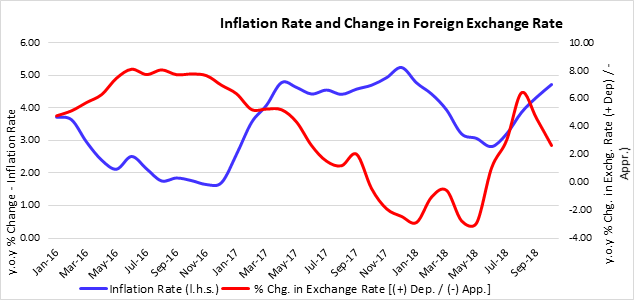
 FOREIGN EXCHANGE MARKET DYNAMICS: WHAT ARE THE FACTORS THAT INFLUENCE THE EXCHANGE RATE? Part 2
FOREIGN EXCHANGE MARKET DYNAMICS: WHAT ARE THE FACTORS THAT INFLUENCE THE EXCHANGE RATE? Part 2
By Tony Morrison, February 2018
There are several major factors, in isolation or in tandem, which can impact the state of the foreign exchange market, and therefore the exchange rate.
These include:
- The current account balance – covered in part 1
- Individual preferences of market participants – covered in part 1
- International market conditions
- External shocks, and
- Inflation
INTERNATIONAL MARKET CONDITIONS – WE ARE THE WORLD
We operate in a global market, and so even when supply and demand and other local dynamics are constant, factors in other markets can still have an influence on ours. One such example is if the US dollar, the dominant foreign currency in our market, loses or gains value relative to other external currencies. A stronger US dollar can mean that our exporters to the United States earn more, but could also encourage more local investors to hold US investment instruments. We also trade with other countries, so someone who exports to the UK or European Union may lose money if they convert back to US$ when the pound or euro loses value to the dollar. Global conditions can also affect local investor confidence, and fears of some impending downturn in the global economy or a spike in oil prices, for example, could prompt a shift towards US dollar holdings or even capital flight, placing pressure on the local market. Conversely, optimistic sentiment about our economy or the global economy in general would have the opposite effect.
EXTERNAL SHOCKS – STUFF HAPPENS
Factors beyond our control sometimes impact our foreign exchange market and therefore the exchange rate. As we saw with the recent global financial crisis, for example, a major and sustained downturn in the global economy in general, and the US market in particular (because they are our major trading partner and major source of tourists), can severely dampen the flow of foreign exchange, which will inevitably result in exchange rate depreciation. Notwithstanding our current efforts to diversify our energy sector and diminish our dependence on imported oil, another spike in oil prices would also exacerbate local demand for foreign currency and again put pressure on the exchange rate.
INFLATION – THE NEW STANDARD
Historically, Jamaica has had long periods and several bouts of high inflation, and our transition to a low inflation economy is still an achievement of recent vintage. When it existed, this high inflation made our balance of payments position worse and encouraged an imbalance in the foreign exchange market, because it meant that locally produced goods were more expensive than similar goods being produced by competitors elsewhere, and also more expensive than the goods we imported. If inflation in Jamaica is much higher than inflation elsewhere, this means a shrinking economy with less earnings from exports and more foreign exchange spent on imports, meaning more pressure on our foreign exchange market.
This is one major reason why the progress we have made in creating a low-inflation economy is so important, and why it is so important that we continue the work in that regard, because the job is not finished. Our exports are more competitive now because our inflation is much lower than it used to be, but even so, it is still higher than the inflation of our major trading partners, and exchange rate movements in free markets normally tend to compensate for the difference in inflation between trading partners. We are already meeting our medium-term target of average inflation consistently being in the range of 4 – 6 per cent, but our ultimate aim is to match our major trading partners, with a range of about 2 – 3 per cent. Until we bridge that gap, if our average inflation each year is roughly 2 -3 percentage points higher than that of our trading partners, then all other things being equal, it would be normal to see an overall depreciation in those years of at least that same 2-3 per cent or close to it. Showing a small appreciation for calendar year 2017 simply means we over-performed in some other area to achieve positive supply conditions.
On this note, however, we must also remember that an economy has to simultaneously pursue multiple objectives, and so while we want to eventually attain trading partner-level inflation of 2-3 per cent, our current imperative of stimulating much-needed growth in the economy is inconsistent with inflation that low, hence the current medium-term target of 4 – 6 per cent.
Our long run objective is to achieve a tolerable rate of inflation for Jamaica – one that does not hurt production incentives by being too high or discourage economic dynamism by being too low. As we approach that point, the exchange rate will progressively decline in importance as a major economic indicator. The inflation rate will be the major number to watch, hence the policy intention to soon adopt explicit inflation targeting as a more aggressive and transparent policy tool to manage inflation.
The progress we have already made in reinforcing a low inflation environment has already had an impact on the foreign exchange market, in terms of limiting the effect of exchange rate fluctuations. One major fear of exchange rate depreciation used to be its impact on local prices, but as our economy has been re-shaped by reforms and grown stronger, so too has our resilience to inflationary impulses and shocks, including depreciation. Up to the 1990’s and a bit later, the measure of sensitivity of inflation to changes in the exchange rate – the so called “pass through” effect of exchange rate movement on overall local prices, was calculated at close to 100 per cent. It fell to 50 per cent at the start of our current reform programme and has fluctuated as low as 30 per since. Still some impact, but drastically reduced from what it used to be.
The historical relationship between the exchange rate and inflation has changed.

Currently, this pass-through factor remains low by historical norms. However, some inflation does come with increased economic activity, and if merchants believe consumers are now better able to absorb price increases, there is more incentive to pass on costs or increase profits by that mechanism. The good thing is that recent bouts of depreciation have mostly been relatively small, so there has not been that much depreciation to transmit. Note as well that those bouts of depreciation have alternated with bouts of appreciation, and since pass-through works both ways, the overall outlook for inflation and consumers is still very positive.
Tony Morrison is a communications specialist at Bank of Jamaica. The original version of this article was previously published in the Jamaica Observer : https://bit.ly/3aR2OL3








